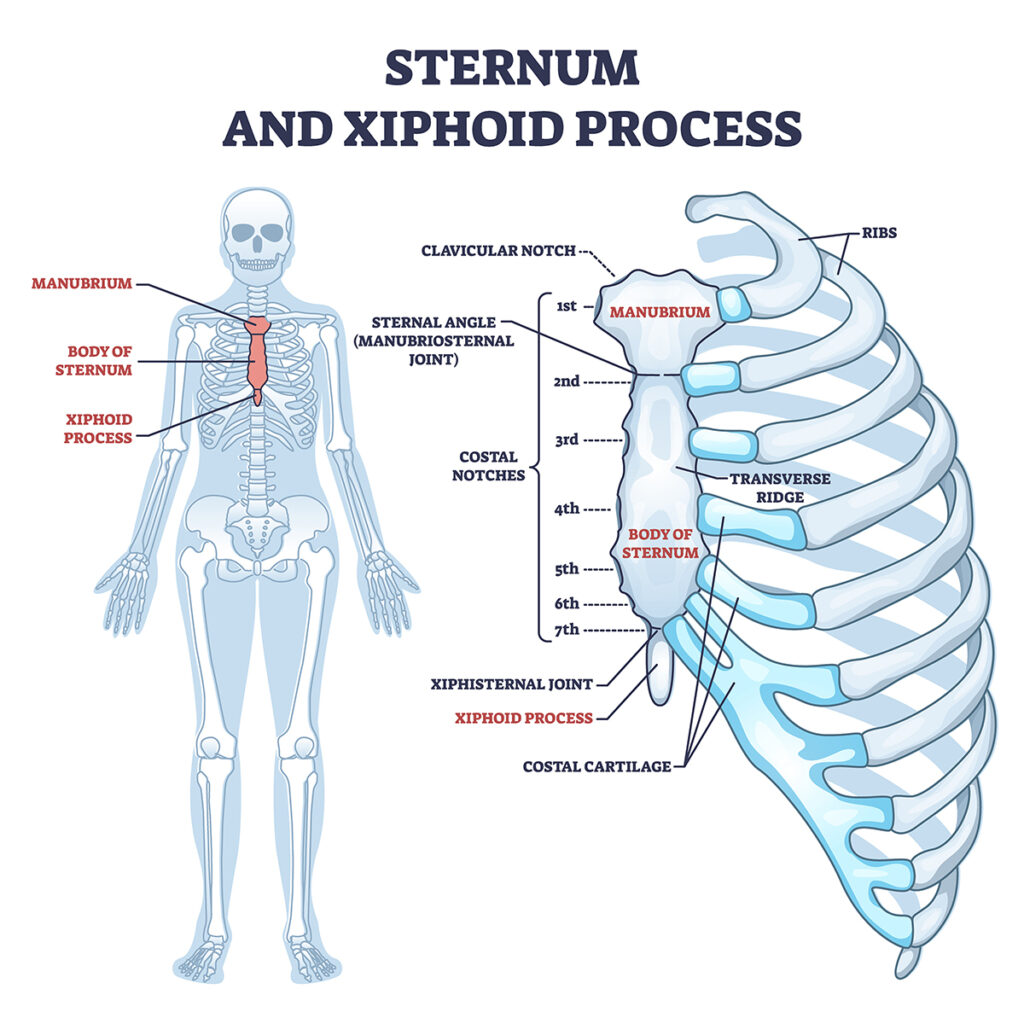
Are you experiencing pain in the lower sternum or chest? This might be xiphoid process pain.
It isn’t a term you hear every day, but it’s crucial to your body’s anatomy. So what is it exactly and where is it located? Find all the answers in our blog!
Xiphoid Process of Sternum
It is a small cartilage at the bottom of the sternum (breastbone). Also, it’s the last part of the sternum to ossify (turn to bone) and stays as cartilage in younger people. Over time, usually by age 40, it becomes more bone-like.
What Is the Shape of the Xiphoid Bone
The xiphoid bone is small and typically shaped like a triangular or sword-like structure. It can be pointed, split, or rounded at the tip, and it gradually becomes flatter as it connects to the rest of the sternum. Its shape can vary slightly from person to person.
Where Is the Xiphoid Process Located
The xiphoid process is located at the bottom of the sternum (breastbone) in the center of the chest. The xiphoid notably acts as an important attachment point for muscles such as the diaphragm, rectus abdominis, and transversus thoracis. These muscle attachments contribute to the functions of the respiratory system and breathing mechanics. Additionally, it stabilizes the ribcage and supports the thoracic region during physical activities.

| The "xiphoid" comes from the Greek word xiphos, meaning "sword," because its shape is somewhat sword-like, with a pointed or blade-like structure in many individuals. |
What Causes Xiphoid Process Pain
While xiphoid is typically unnoticeable, if it is injured owing to inflammation, trauma, or other factors, it leads to severe pain.
Here are some common causes:
- Direct Hit: A blow to the chest, such as from a fall or accident, can injure the xiphoid process of the sternum, therefore causing pain.
- Repetitive Strain: Lifting heavy objects or performing certain physical activities too often can strain the muscles.
- Muscle and Cartilage Inflammation: Inflammation of the diaphragm or the cartilage connected to the xiphoid can increase discomfort.
- Acid Reflux or GERD (gastroesophageal reflux disease): Acid from the stomach can move into the chest, creating a burning sensation.
- Stomach Problems: Conditions like gastritis or stomach ulcers in the upper abdomen can contribute to discomfort around the xiphoid area.
- Poor Posture: Sitting or standing with bad posture can strain the muscles.
- Shallow Breathing: Stressing the diaphragm with shallow breathing can lead to discomfort.
- CPR Injury: Incorrect CPR techniques can lead to fractures or injury.
- Pregnancy: As the body changes during pregnancy, pressure on the xiphoid bone can create discomfort, especially in the later stages.
Xiphoid Process Symptoms You Shouldn't Ignore
They usually arise from either injury, inflammation, or conditions affecting the surrounding muscles and structures. The most common symptoms that help you recognize it are:
1. Pain or Tenderness:
One of the most common symptoms is localized pain or tenderness. Especially when pressure is applied to the area. The pain can be sharp, aching, or a dull discomfort, and it may worsen when moving, breathing deeply, or coughing.
2. Swelling:
In cases of xiphoid process inflammation (xiphodynia), the area around it may become swollen or a lump in the chest may show up. It might be painful and more noticeable in certain positions.
3. Referred Pain:
From time to time, the pain can travel to the chest, upper abdomen, or back. This gives the sensation of originating from a deeper or more internal area, such as the stomach or heart.
4. Difficulty Breathing or Discomfort with Movement:
Feeling discomfort during activities like deep breathing, bending, or twisting are also common symptoms. Moreover, the pain may intensify when engaging in activities that involve the diaphragm, like heavy lifting or physical exercise.
5. Heartburn or Acid Reflux:
Occasionally, people feel symptoms like heartburn or acid reflux, which can happen because the xiphoid is close to the stomach area.
6. Bruising or Signs of Trauma:
A direct hit to the chest, like from a fall or accident, can cause bruising or color changes around the xiphoid, which may mean the cartilage or bone is hurt.
Most of these symptoms are temporary, so you may not notice the concern immediately. However, if they persist, it's important to see a doctor to rule out any serious underlying issues.
Cancer Lump on Sternum
It is a growth or swelling in the chest area, usually around the breastbone. While it can be caused by various factors, including cancer, it’s important to get it checked by a doctor to determine the cause. The lump could indicate either a primary cancer, such as breast cancer, or a spread from another part of the body. Therefore, early diagnosis and treatment are crucial for the best outcome.
How Xiphoid Process Issues Are Diagnosed
If you are facing excessive pain or a lump in the middle of the chest between the ribs, then it's time to diagnose. The diagnosis often includes:
1. Medical History Review: The doctor asks about the pain—when it started, how long it’s lasted, and how intense it is. In addition to this, they ask about activities or injuries that might have caused the pain.
2. Physical Examination: The doctor gently presses around the xiphoid process to check for tenderness, swelling, or pain. Thus helping him see if these movements make the pain worse.
3. Imaging Tests (if needed):
- X-rays: These help find fractures or other issues in the chest, though they don’t always show problems with the xiphoid itself.
- Ultrasound or MRI: The doctor conducts it to suspect soft tissue damage or if the pain continues despite a clear diagnosis.
- CT Scan: It is conducted in rare cases when the doctor needs a more detailed look at the chest or abdominal area.
4. Exclusion of Other Conditions: The doctor will check for other conditions that might cause similar symptoms, such as:
- Heart Disease: If the doctor suspects a heart problem, they might do tests like an EKG or a stress test.
- Gastrointestinal Problems: To check for stomach problems such as acid reflux or ulcers, the doctor may conduct an endoscopy or blood test.
5. Diagnosis of Xiphodynia: If the pain is found to be from the xiphoid process, the condition is called xiphodynia. This means it is inflamed or irritated. It's usually not serious, but it can cause discomfort or pain.
How to Manage and Treat Xiphoid Process Pain
Treating the underlying cause is the best way to resolve xiphoid pain. Below are some common treatments that can provide relief.
1. Rest and Avoide Strain:
Take rest from heavy lifting or hard workouts to help healing. Moreover, avoid pressing directly the xiphoid area to prevent more pain.
2. Pain Relief:
To ease pain and xiphoid process inflammation, consider taking ibuprofen or acetaminophen (with your doctor’s advice). Besides this, you can apply ice for 15-20 minutes a few times a day.
3. Physical Therapy:
A physical therapist can guide you through exercises to strengthen and stretch the muscles. Moreover, the exercises help improve posture and prevent future pain.
4. Heat Therapy:
If muscle tension is to blame, using a warm compress or heating pad can help relax the muscles and alleviate pain.
5. Diet and Lifestyle Changes:
The pain might arise due to acid reflux. So, you can take medications to reduce stomach acid or change your diet.
6. Surgical Intervention (in rare cases):
In most cases, surgery is not necessary. However, if there is a hard lump on the rib cage that feels like bone or a lump on the sternum, surgery is the last resort.
Xiphoidectomy is a surgery to remove the xiphoid process.
Healing Your Xiphoid Process Surgery: Simple Aftercare Steps
If your condition is severe, surgery may be necessary. The surgery takes 4-6 weeks to heal. In that case, it's crucial to follow proper aftercare to promote healing and prevent complications.
- Give your body time to heal. Avoid strenuous activities, heavy lifting, or exercises for a few weeks after the surgery.
- Take prescribed pain medication as directed by your doctor. Over-the-counter pain relievers like ibuprofen or acetaminophen may also help (with a doctor's approval).
- Apply ice to the affected area for the first few days to reduce swelling, and after that, you may switch to a heating pad to help with muscle tension.
- Attend follow-up appointments with your doctor to ensure your surgery is healing properly.
- Keep the incision area clean and dry. Follow your doctor's instructions on how to care for the surgical site to prevent infection.
- Gradually ease back into daily activities. Start with light activities and avoid any heavy lifting or intense movements that could strain the chest area.
- Practice deep breathing exercises to maintain good lung function, especially if the diaphragm was involved in the surgery.
Xiphoid Process Treatment Costs: What to Expect
The pain can usually be managed through medication, and physical or heat therapies. However, if your xiphoid process is damaged, injured, or broken, a surgeon might remove it.
The cost of the xiphoid process surgery may range between $5,000-$6,000.
Over and above that, the cost can vary according to:
- The location where the clinic or hospital is located.
- The experience of the surgeon.
- The severity of the case.
- Additional costs like X-rays, CT Scan, MRI, EKG, etc.
The Final Thoughts
Despite its small size, the xiphoid process is an essential part of the chest anatomy, both structurally and functionally. Pain in this area can be really stressful and make it hard to get through the day. If the pain persists, it’s important to consult a doctor for a proper diagnosis. Your doctor might recommend medication or physical therapy, and in rare cases, surgery (xiphoidectomy) could be required.
To manage the cost affordably, consider Denefits flexible payment plans. Many providers already use it to help patients finance their care, and you can find the support you need.
Frequently Asked Questions (FAQs)
1. Can I Get My Xiphoid Process Removed?
Yes, xiphoid process removal, known as xiphoidectomy, can be done if the area causes chronic pain or discomfort that doesn’t improve with other treatments. It’s typically considered a last resort option after other remedies fail.
2. What Is the Recovery Time for Xiphoid Surgery?
Recovery from xiphoidectomy surgery typically takes about 4 to 6 weeks. During this time, you may need to rest and avoid heavy activities. It's important to follow your doctor's advice for a smooth recovery, and pain or swelling should gradually reduce as the area heals.
3. How To Fix the Protruding Xiphoid Process?
Non-surgical options like physical therapy or posture correction exercises may help alleviate discomfort. In more severe cases, surgery (xiphoidectomy) may be recommended to remove the protrusion.
4. Are There Any Xiphoid Process Cancer Symptoms?
Xiphoid process cancer is extremely rare, but if it occurs, symptoms might include persistent pain, swelling, or a noticeable lump on the chest bone or rib cage.
5. Why My Xiphoid Process Stick Out?
A protruding xiphoid process can occur due to factors like genetics, abnormal growth, or muscle tension around the area. It may also become more noticeable in some individuals as they lose body fat or if there’s any trauma or injury to the chest.
6. What Is Hard Lump on the Rib Cage That Feels Like Bone?
A hard lump on the rib cage that feels like bone could be a harmless growth like a bone spur or cartilage overgrowth. It may also be a result of past injury, inflammation, or a benign tumor. If it's painful or growing, it's best to see a doctor.


